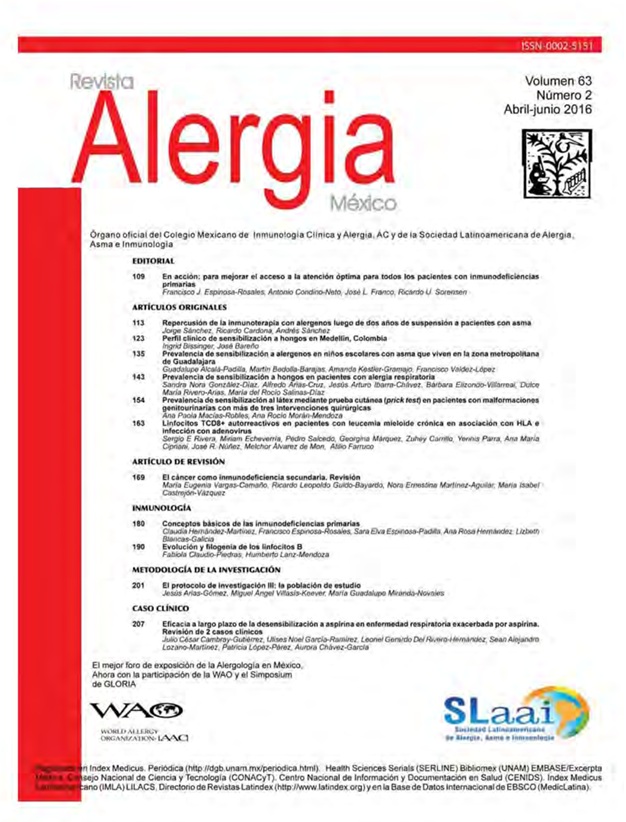Abstract
Background: As part of the etiology of respiratory allergy we have genetics, prenatal factors and sensitivity to various airborne allergens, between these fungi are found. Relationship has been found between sensitization to fungal in skin tests and allergy pathogenesis and aggravation. There is a few literature in Mexico and in the north of the country it is lacking regarding this problem.
Objective: Assess the prevalence of sensitization to fungi in patients with respiratory allergy in skin tests to airborne allergens; determine the most prevalent fungus and prevalence of sensitization to each species of fungus per year, to assess the prevalence of sensitization to fungi by years.
Material and method: Cross-sectional, observational and descriptive study conducted from 1 January 2010 to 31 December 2014 in patients treated at the Regional Center of Allergy and Clinical Immunology (Monterrey, Mexico) where we reviewed a database with patients whom performed skin tests, sensitization to 6 species of fungi were evaluated. We performed tables of data capture and statistical analysis.
Results: 4880 patients had respiratory allergy, a 17.1% prevalence of sensitization to fungal skin tests was determined. The fungus specie most prevalent was Alternaria alternata with 5.5%. The year range with the highest prevalence of sensitization was 0-10 years with a 6.7%
Conclusion: The prevalence of fungi sensitization was higher than the global prevalence found, but lower than the prevalence found in other researches in Mexico.
References
Serrano C, Valero A, Picado C. Rinitis y asma: una vía respiratoria, una enfermedad. Arch Bronconeumol. 2005;41(10):569-78.
Bousquet J, Khaltaev N, Cruz AA, et al. Allergic Rhinitis and its Impact on Asthma (ARIA) 2008 update (in collaboration with the World Health Organization, GA(2)LEN and Aller- Gen). Allergy. 2008:63(86);8-160.
Subbarao P MD MSc, Mandhane PJ MD PhD, Sears MR MB ChB. Asthma: epidemiology, etiology and risk factors. CMAJ. 2009:181(9);E181-90.
Zureik M, Neukirch C, Leynaert B, et al. Sensitisation to airborne moulds and severity of asthma: cross sectional study from European Community respiratory health survey. BMJ. 2002:325(7361);411-4.
Guidelines on Assessment and Remediation of Fungi in Indoor Enviroments. New York City Department of Health and Mental Hygiene, 2008 http://www.nyc.gov/html/doh/ downloads/pdf/epi/epi-mold-guidelines.pdf
Rodríguez-Orozco AE, Moreno-Chimal K, Méndez-López TT, et al. Prevalencia comparada de sensibilización a géneros de hongos alergénicos en pacientes con alergias respiratorias provenientes de Michoacán y Altos de Jalisco- León, Gto., años 2004-2006 vs 2007-2009. Rev Mex Micol. 2010;32:1-9.
Bedolla-Barajas M, Morales-Romero J, Hernández-Colín DD, et al. Prevalencias de sensibilización a alergenos más comunes en adultos mayores del Occidente de México. Rev Alergia Mex. 2012;59(3):131-8.
Valero A, Pereira C, Loureiro C, et al. Interrelationship Between Skin Sensitization, Rhinitis, and Asthma in Patients With Allergic Rhinitis: A Study of Spain and Portugal. J Investig Allergol Clin Immunol 2009;19(3):167-72.
Díaz-Rodríguez A, Fabré-Ortiz DE, Coutin-MarieI G, et al. La sensibilización a hongos ambientales y su relación con enfermedades atópicas en escolares. Revista Cubana de Medicina General Integral.2010; 26(4)647-55.
Pendino P MD, Agüero C MD, Cavagnero Paola MD, et al. Aeroallergen Sensitization in Wheezing Children From Rosario, Argentina. World Allergy Organ J. 2011; 4:159–63.
Ortega-López MC, De-la-Hoz JA, León DA, et al. Prevalencia de sensibilización en pacientes pediátricos con sospecha o diagnóstico de enfermedad alérgica. Estudio PRESPPENAL1. Med Bogota Colomb. 2014;36(3):234-46.
Sánchez-Caraballo J, Díez-Zuluaga S, Cardona-Villa R. Sensibilización a aeroalergenos en pacientes alérgicos de Medellín, Colombia. Rev Alergia Mex. 2012;59(3):139- 147.
Tincopa A L, Gudiel H A, Gudiel H J, et al. Sensibilización a neumoalergenos en niños con rinitis alérgica en Lima Norte. Rev Peru Pediatr. 2004:6-11- 14. Bartra-Tomás, J.Mapa fúngico y estudio multicéntrico de sensibilización a hongos en Cataluña. Alergología e Inmunología Clínica. 2003 18:106-11.
Bedolla-Barajas M, Hernández-Colín DD. Sensibilización a aeroalergenos en sujetos con rinitis alérgica que viven en la zona metropolitana de Guadalajara. Rev Alerg Mex. 2010;57(2):50-6.
Baptistella E, Maniglia S, Malucelli DA, et al. Allergen-Specific Immunotherapy in Patients 55 Years and Older: Results and Review. Int Arch Otorhinolaryngol 2013;17:375-9.
Dharmage SC, Lowe AJ, Matheson MC, et al. Atopic dermatitis and the atopic march revisited. Allergy 2014;69:17- 27.
Beezhold DH, Green BJ, Blachere FM, et al. Prevalence of allergic sensitization to indoor fungi in West Virginia. Allergy Asthma Proc. 2008;29(1):29-34.
Balenga NA, Klichinsky M, Xie Z, et al. A fungal protease allergen provokes airway hyper-responsiveness in asthma. Nat Commun. 2015;13;6:6763
Apter AJ MD MSc MA. Advances in adult asthma diagnosis and treatment in 2014. J Allergy Clin Immunol. 2015;135:46-53.
Toppila-Salmi S, Huhtala H, Karjalainen J, et al. Sensitization pattern affects the asthma risk in Finnish adult population. Allergy. 2015 Sep;70(9):1112-20.
Muñoz-del-Castillo F, Jurado-Ramos A, Soler R, et al. Fungal Sensitization in Nasal Polyposis. J Investig Allergol Clin Immunol 2009;19(1):6-12.
Gergen PJ MD MPH, Turkeltaub PC MD, Kovar MG DrPH. The prevalence of allergic skin test reactivity to eight common aeroallergens in the U.S. population: Results from the second National Health and Nutrition Examination Survey. J Allergy Clin Immunol. 1987; 80(5);669-79.

This work is licensed under a Creative Commons Attribution-NonCommercial 4.0 International License.
Copyright (c) 2016 Revista Alergia México

